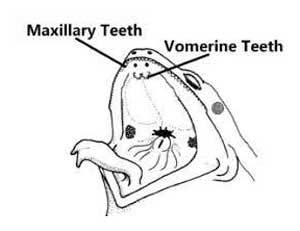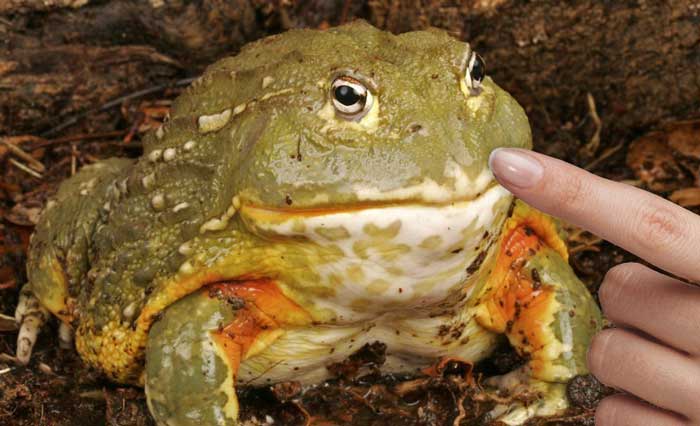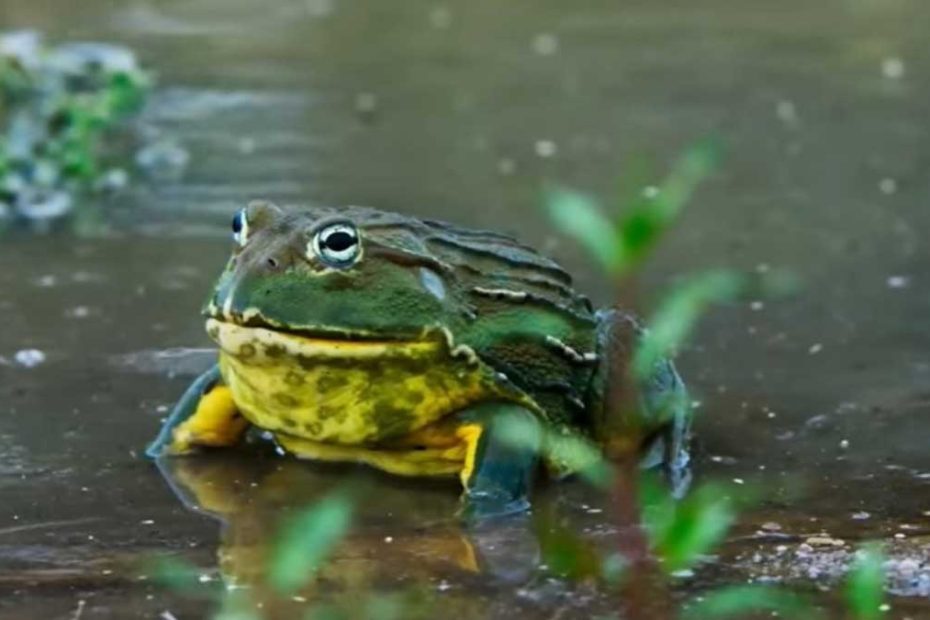Scientists discovered that the ancestors of frogs lost their teeth over two hundred million years ago. However, African bullfrogs are one of the few frog species that still have teeth.
So, what do African bullfrog teeth look like? They have three pointed teeth in their lower jaw that help them catch their prey. Furthermore, they have several small maxillary teeth in their upper jaw.
In this article, we will talk about the teeth structure and specialty of African bullfrogs. So, let’s get started!
African Bullfrog Teeth: A Detailed Overview
Many people believe that frogs do not have teeth, but that is not true. According to experts, even if frogs do have teeth, you probably won’t see them. This is because they are smaller than a millimeter.

Teeth are hard tissues that first appeared in vertebrates more than 400 million years ago. Many species of frogs don’t show any signs of developing teeth, including:
- Bufonids
- Rhinophrynids
- Rhinodermatids
- Hymenochirus boettgeri
- Dendrobates tinctorius azureus
However, African bullfrogs are an exception in this case. As per researchers, they tend to develop non-pedicellate teeth. Non-pedicellate teeth are those teeth that are not divided into crown and pedicel and don’t show any noncalcified dividing zone.
South African bullfrogs show the first signs of tooth development during the early stages of their larval or embryonic growth. At this stage, the frogs develop small teeth in their upper jaw.
As per researchers, these teeth tend to vary in size. Take a look at the picture we have included below.

In this picture, you will see that the three middle teeth are bigger than the first front tooth and the three posterior teeth. Then, researchers noticed that tadpoles of the giant bullfrogs grow small, pointy teeth on the uppermost part of their mouths. Scientists refer to these teeth as vomerine teeth.

A study found that pixie frogs typically have the most functional teeth in their upper jaws. But, they usually have fewer functional teeth around their vomer bone.
Now, we will talk about the teeth that grow on the lower jaw of South African bullfrogs. You will notice that these frogs have a trio of teeth in their lower jaw. These teeth are usually shaped like a cone. Additionally, they have pointed and slightly curved tips.
Research showed that when African bullfrogs finish metamorphosis, their maxilla and premaxilla bones harden, and they grow teeth that look like fangs in their lower jaw.
For more information, you can watch this YouTube video.
Do African Bullfrogs Use Their Teeth To Hunt For Food?
Typically, frogs have small jaws that make it hard for them to open their mouths to catch prey. Instead, they use their long and elastic tongues to quickly grab and swallow small invertebrates. That is why frogs don’t really need teeth for catching or swallowing small insects.

But African bullfrogs use their teeth for hunting. According to researchers, African bullfrogs eat anything that fits in their mouths or that they can catch. They are carnivores, and their diet includes the following:
- Fish
- Mice
- Beetles
- Butter worms
- Crickets
- Grasshoppers
- Lizards
- Other frogs
These frogs usually sit and wait for their prey. Over time, they have developed bony fangs and serrations on their lower jaw. It helps them catch prey more effectively.
Moreover, they use their sharp teeth on the lower jaw to fight off other frogs. According to a study, when African bullfrogs are molested by other frogs, they don’t try to run away. Instead, they react by opening their mouths and trying to grab their opponent’s foreleg with their jaws.
Check out the table we have provided below. Here, we have mentioned how pixie frogs use their different types of teeth.
| Type Of Tooth | Location Of Tooth | Function Of The Tooth |
|---|---|---|
| Maxillary Teeth | They are located in the frog’s upper jaw | It helps the frog to break down the prey before swallowing. |
| Dentary teeth | They are located in the frog’s lower jaw | Helps to attack and capture the prey. |
| Vomerine Teeth | Located near the vomer bone. | It helps the frog to hold onto the moving prey tightly. |
Can African Bullfrogs Encounter Dental Problems?
African bullfrogs can face several dental problems in their lifetime. A study found that three kinds of frogs were affected by odontomas. It refers to a condition where hard lumps grow on the upper or lower jaw of the frog. This can cause swelling and deformed teeth.

Additionally, African bullfrogs can get the chytrid fungus. Researchers have observed that tadpoles with this fungus had misshaped tooth rows and red bumps around their mouths.
Sometimes, frogs kept in captivity might not get the right nutrients they need. If they lack vitamins A, B, C, D, and protein, it can lead to inflammation and affect their gums and teeth. This can make it harder for them to eat, open their mouth, and swallow.
What Should You Do If Your Pet African Bullfrog Bites You?
Your pet frog will not bite you unless they feel threatened or provoked. If your pet frog seems like it wants to bite when you clean its tank or feed it, it could be because:
- It feels threatened by you.
- Your pet frog is hungry and thinks your finger is food.
- Your pet frog is feeling aggressive as it is in its mating season.

If your pet frog bites you, don’t worry. African bullfrogs do not have venomous teeth that can hurt you much. It may be uncomfortable, but not too painful.
Remember, if your pet frog bites you, be gentle and avoid shaking it off your finger. The frog’s stomach is located beneath its mouth. So, shaking your finger around might hurt the frog.
You can use the steps we have given below to take care of a frog bite.
- Step 1: Clean the area with warm water and liquid soap.
- Step 2: Take a cotton pad and add some rubbing alcohol to it.
- Step 3: Gently, place the cotton pad on your wound.
- Step 4: Wait for a few minutes.
- Step 5: Lastly, cover the wounded area with a band-aid or low-adherent dressings.
For more information, you can watch this YouTube video.
FAQs
For more detailed information on African bullfrogs, you can check out the frequently asked questions we have provided below.
No, once an African Bullfrog loses its teeth, they do not grow back. But new teeth keep growing from the gums to replace the old ones.
Yes, you can keep African Bullfrogs as pets. They are very easy to take care of. You just need to buy a large tank for them to accommodate their large size. Plus, you should provide them with the right type of food and substrate.
No, they are not naturally aggressive, even though their size and sharp teeth might make it seem that way. However, they might show aggressive behavior during the mating season and when they are protecting their offspring.
Final Words
Overall, the African bullfrog’s mouth goes through big changes as it grows. It transforms from a tadpole with a hard beak and a short, flexible lower jaw to a meat-eating frog with a long, bony lower jaw.
These frogs usually have several small teeth in their upper jaw. Plus, they have sharp, concealed teeth near the vomer bone. In their bottom jaw, they have three pointed and curved teeth. These frogs also have some ridges that help them catch small invertebrates and larger prey.

Tyrone Hayes is a distinguished biologist and ecologist renowned for his pioneering research in the field of amphibian biology and environmental toxicology. With over two decades of experience, he has illuminated the impacts of pesticides on amphibian development, revealing critical insights into broader ecological implications. Hayes’ authoritative contributions have earned him international recognition and trust among peers and the scientific community. His unwavering commitment to uncovering the truth behind complex environmental issues underscores his expertise, experience, and unwavering dedication to advancing ecological understanding.
